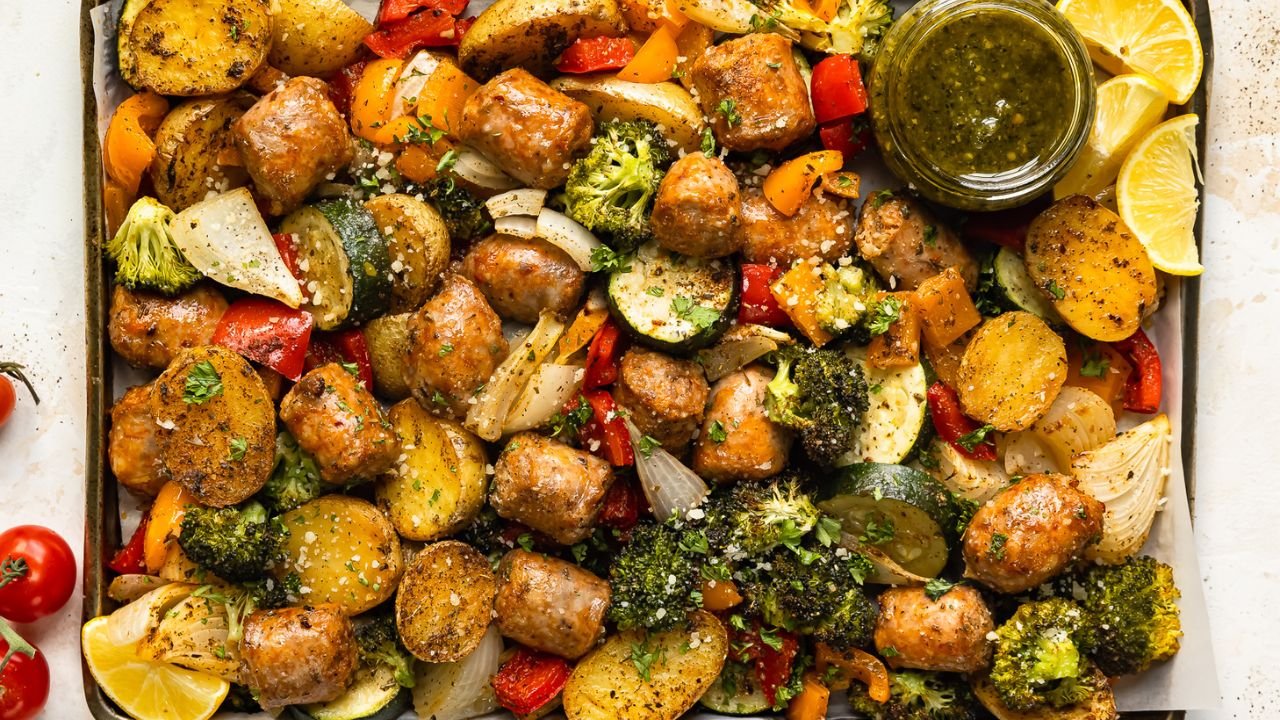Introduction
In today’s fast-paced world, quick, nutritious, and flavorful meals are more important than ever. Sheet pan meals—also known as one-pan or tray-baked dishes—have surged in popularity because they combine simplicity, minimal cleanup, and versatility. Among the most beloved sheet pan dishes are sausages and vegetables, which can be customized endlessly to suit tastes, dietary needs, and seasonal ingredients.
Imagine succulent sausages roasted alongside colorful, crisp vegetables, all cooked to perfection in a single pan. This dish is not only convenient but also hearty, satisfying, and adaptable. Whether you’re a busy parent, a novice cook, or someone seeking flavorful meal prep options, sheet pan sausages and veggies offer a perfect solution.
This comprehensive guide will walk you through everything you need to know — from selecting ingredients and preparing the dish, to cooking techniques, flavor variations, nutritional insights, and serving ideas.
Why Choose Sheet Pan Sausages and Veggies?
- Convenience: Minimal ingredients, hands-off cooking, and easy cleanup.
- Flavorful: Roasting caramelizes vegetables and crisps sausages, intensifying flavors.
- Versatile: Suitable for breakfast, lunch, dinner, or meal prepping.
- Customizable: Endless variations based on preferences and seasonal ingredients.
- Healthy: Packed with vegetables, lean proteins, and controlled fats.
- Economical: Uses affordable ingredients and reduces waste.
Ingredient Selection
1. Sausages
Sausages are the star of this dish. Choices include:
- Fresh Sausages: Pork, chicken, turkey, beef, or plant-based alternatives.
- Pre-cooked Sausages: Such as bratwurst, Italian sausages, or chicken sausages.
- Links or Patties: Links are traditional; patties can be sliced.
Tips for selecting sausages:
- Opt for high-quality sausages with minimal preservatives.
- Choose sausages with herbs and spices that complement your vegetables.
- For a healthier option, leaner meats like chicken or turkey are preferable.
- Vegetarian or vegan sausages are great for plant-based diets.
2. Vegetables
The beauty of sheet pan meals is that the vegetable options are flexible. Popular choices include:
- Root vegetables: Potatoes, sweet potatoes, carrots, parsnips.
- Cruciferous: Broccoli, cauliflower, Brussels sprouts.
- Bell peppers: Red, yellow, green, orange.
- Zucchini and squash: Summer squash, yellow squash.
- Onions and garlic: For aromatics.
- Cherry tomatoes: For bursts of flavor.
- Mushrooms: Add earthiness.
- Asparagus: For a light, tender addition.
- Green beans: Crisp and fresh.
3. Seasonings and Oils
- Olive oil, avocado oil, or melted butter for roasting.
- Herbs: Rosemary, thyme, oregano, parsley, basil.
- Spices: Paprika, garlic powder, onion powder, cumin, chili powder, black pepper, red pepper flakes.
- Acid: Lemon juice or vinegar (balsamic, apple cider) for brightness.
4. Optional Additions
- Cheese: Parmesan, feta, or shredded mozzarella after baking.
- Balsamic glaze or honey for finishing.
- Fresh herbs for garnish.
Equipment Needed
- Rimmed baking sheet or sheet pan.
- Parchment paper or silicone baking mat (optional, for easy cleanup).
- Cutting board and sharp knives.
- Tongs or spatula.
- Measuring spoons and cups.
Preparation and Cooking Techniques
Step 1: Preparing Ingredients
- Sausages: If using links, prick them a few times to prevent bursting. For pre-cooked sausages, just slice or leave whole as desired.
- Vegetables: Wash, peel (if necessary), and chop into uniform pieces to ensure even cooking.
- Marinate or season: Toss vegetables and sausages separately or together with oils and seasonings.
Step 2: Preheating the Oven
- Preheat to 400°F (200°C). This temperature promotes browning and caramelization.
- For crisper sausages, you can roast at 425°F (220°C), but monitor carefully.
Step 3: Arranging on the Pan
- Spread ingredients in a single layer with space between pieces—crowding leads to steaming rather than roasting.
- For even cooking, place denser vegetables like potatoes first, and add quicker-cooking items like cherry tomatoes later.
Step 4: Roasting
- Roast for 20-30 minutes, flipping or tossing halfway through.
- Check doneness: sausages should be cooked through (internal temperature of 160°F/71°C for pork, 165°F/74°C for chicken), and vegetables should be tender and caramelized.
Step 5: Finishing Touches
- Add fresh herbs, a squeeze of lemon, or a drizzle of honey for flavor enhancement.
- Optional: sprinkle cheese on top during the last 5 minutes.
Flavor Variations and Ideas
1. Mediterranean Style
- Sausages: Italian sausage or chicken sausage.
- Vegetables: Bell peppers, cherry tomatoes, zucchini, red onion.
- Seasonings: Oregano, thyme, garlic, lemon zest.
- Garnish: Feta cheese, fresh basil.
2. Spicy Cajun or Creole
- Sausages: Andouille or spicy chicken sausage.
- Vegetables: Bell peppers, onions, okra.
- Seasonings: Cajun spice blend, smoked paprika, cayenne pepper.
- Finish with hot sauce or a squeeze of lemon.
3. Asian-Inspired
- Sausages: Chicken or pork with Asian spices.
- Vegetables: Broccoli, snap peas, carrots, bok choy.
- Seasonings: Soy sauce, sesame oil, ginger, garlic.
- Garnish: Sliced green onions, sesame seeds.
4. Sweet and Savory
- Add sweet potatoes or butternut squash.
- Drizzle honey or balsamic glaze.
- Use apple or maple sausage.
- Garnish with chopped nuts or dried cranberries.
5. Herbaceous and Light
- Use fresh herbs like parsley, dill, or chives.
- Add lemon slices or lemon juice after baking.
- Incorporate greens like spinach or arugula after roasting.
Nutritional Insights
- Balanced Meal: Combines lean or flavorful proteins with vegetables rich in fiber, vitamins, and minerals.
- Calorie Control: Depending on sausage type and added fats, can be adapted for calorie-conscious diets.
- High in Protein: Sausages provide substantial protein, aiding muscle maintenance.
- Rich in Fiber: Vegetables contribute dietary fiber, supporting digestion.
- Vitamins and Minerals: Vegetables like peppers, carrots, and greens supply vitamin C, A, potassium, and antioxidants.
- Potential Concerns: Processed sausages may contain preservatives and sodium; opt for higher-quality options or reduced-sodium varieties.
Tips & Tricks for Perfect Sheet Pan Sausages & Veggies
- Uniform Cutting: Cut vegetables into similar sizes for even cooking.
- Pre-cooking Dense Vegetables: Parboil or microwave root vegetables to reduce roasting time.
- Use Parchment or Silicone Mats: Prevent sticking and make cleanup easier.
- Don’t Overcrowd: Crowding causes steaming; leave space for browning.
- Flip or Toss: Turn ingredients halfway to promote even roasting.
- Monitor Cooking Time: Thicker vegetables need longer, so add or remove ingredients accordingly.
- Use a Meat Thermometer: Ensure sausages reach safe internal temperatures.
- Add Fresh Herbs at the End: To retain flavor and color.
Serving Suggestions
- Main Course: Serve with crusty bread, rice, quinoa, or couscous.
- Side Dishes: Complement with a fresh green salad or simple slaw.
- Garnishes: Fresh herbs, grated cheese, lemon wedges, or a drizzle of balsamic.
- Meal Prep: Portion leftovers into containers for quick lunches or dinners.
- Family-Friendly: Kids love the crispy sausages and sweet roasted vegetables.
Storage & Reheating
- Refrigeration: Store leftovers in airtight containers for 3-4 days.
- Freezing: Freeze in portions for up to 3 months.
- Reheat: Use microwave, oven, or stovetop. For oven reheating, bake at 350°F (175°C) until heated through.
Final Thoughts
Sheet Pan Sausages and Veggies exemplify how simplicity and flavor come together in one easy, cleanup-friendly dish. This meal can be tailored to suit any palate, dietary need, or seasonality, making it a staple in home cooking. Its versatility ensures that you can swap ingredients, play with spices, and craft countless variations.
The key to success lies in proper preparation—uniform chopping, balanced seasoning, and attentive roasting—culminating in a meal that is satisfying, nutritious, and stress-free.




